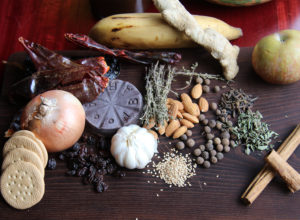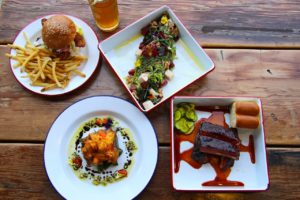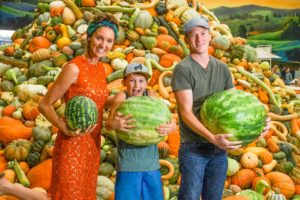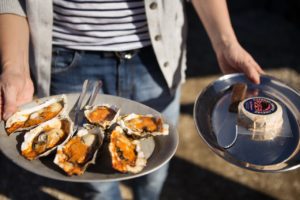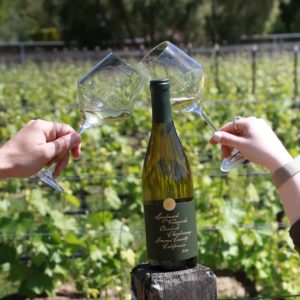Maine is famous for its lobster, New Mexico for Hatch chiles and Iowa for corn.
But in the magical foodshed that is Sonoma County, we’re renowned for so many wondrous things, it’s tough to keep track.
Each season pulls its own delights from Mother Nature’s larder, from winter citrus to spring strawberries, summer tomatoes and fall figs. The bounty is so rich that many local restaurants tend their own farms, like the girl & the fig, Handline and Peter Lowell’s, Barndiva, zazu kitchen + farm and Single Thread.
We’re blessed with Bodega Bay rockfish, crab, salmon, steelhead and halibut, pastured beef and dairy from meadows and mountains all around, wild mushrooms waiting to be foraged in our forests, and so many spectacular artisanal cheeses that there’s even an official Cheese Trail mapping our nearly three dozen farms and creameries.
So abundant are our edible treasures that Sonoma County chefs have coined a term all their own: hyper-local, meaning their menus are built not just on California or even Sonoma County sourcing, but ingredients from within the very town the restaurant calls home.
And constantly, we’re adding more to our pampered pantry. Coveted local ingredients now include Sonoma Coast seaweed, Pacific Ocean-harvested salt and pickles as an entire food group.
Join us, then, for a flavor-fueled adventure with this Top 10 must-eat guide to Sonoma County signatures.
DUCK
What: Our most famous bird comes from Liberty Ducks/Sonoma County Poultry in Penngrove, where founder Jim Reichardt is a fourth-generation farmer specializing in a cultivated strain of large-breed Pekin Duck celebrated for its rich, highly flavorful meat. Pasture raised year-round on an all-natural, mostly grain diet, the birds are sustainably “whole animal” harvested, to feed gourmet recipes showcasing everything from breast and wings to gizzards, heart, tongue and even tiny, tasty feet.
Where: At the new Pinoli Cucina Rustica in Guerneville, chef-owner Christian Darcoli marries several Wine Country classic ingredients for his sumptuous Liberty duck breast glazed in 2010 Novy Family Wines Russian River Oley Late Harvest Viognier, prettied up with seasonal local berries atop Italian farro.
Recipe: Duck Breast with Farro, Seasonal Berries and Late Harvest Wine
Pinoli Cucina Rustica, Guerneville Courtesy Chef-Owner Christian Darcoli, Serves 1
3 cups water
1 cup farro
2¼ teaspoons salt, divided
5 ounces boneless, skin-on Liberty duck breast
¼ teaspoon pepper
½ cup mixed berries
5 ounces late harvest white wine
½ cup vegetable broth
1 ounce butter
¼ teaspoon thyme
¼ teaspoon minced fresh garlic
Combine the water and farro in a medium saucepan. Add 2 teaspoons of the salt. Bring to a boil. Reduce the heat to mediumlow, cover, and simmer until the farro is tender, about 30 minutes. Drain well, and then transfer to a large bowl to cool.
Season duck with pepper and remaining ¼ teaspoon salt. Heat a well-seasoned skillet or nonstick sauté pan over high heat. When
pan is hot, add duck breast, skin side down, and cook for 8 to 10 minutes, or until skin is brown and crispy. Flip and cook for 5 more minutes. Remove from pan and let meat rest, reserving the juices in the pan. Heat the same pan to medium high. Add the berries and late harvest wine to the duck jus and cook until reduced by half. Add the broth and reduce by half again, then whisk in butter and cook for 3 minutes.
Pre-heat oven to 500°.
Place farro in another pan, and sauté briefly with thyme and garlic.
Spoon farro onto a plate, top with sliced duck breast, and warm in oven for 7 minutes. Remove plate from oven, drizzle berry sauce over duck and serve immediately.
FREE-RANGE CHICKEN
What: From their first peek out of the shell at hatching through their happy lives pecking in pasture, our pampered bird breeds like Rocky The Free-Range Chicken from Petaluma Poultry enjoy a 100 percent vegetarian diet and a natural environment to live like, well, chickens. They reward us with succulent, juicy meat that’s made Rocky birds national stars since farmer Allen Shainsky founded his ranch in 1969.
Where: Barndiva owners Jil and Geoffrey Hales are so dedicated to farm-to-fork that Jil produced a film, called “Eat the View,” documenting the journey one plate takes as the ingredients travel across Sonoma County, through the Healdsburg restaurant’s kitchen, and into the dining room. Chef Ryan Fancher impresses with his crispy roasted Rocky chicken in its own jus, plated with a ragout of roasted local mushrooms from Wine Forest Wild Foods forager Connie Green, Hobbs bacon, egg yolk ravioli made with eggs from Angerer Family Farm in Geyserville and Bellwether Farms Whole Milk Basket Jersey ricotta from Petaluma — all finished in chive oil, basil, greens, herbs and edible flowers plucked from Barndiva Farm.
Recipe: Crispy Free-Range Roast Chicken with Fresh Corn-Chanterelle Mushroom Ragout and Ricotta-Egg Yolk Ravioli
Barndiva, Healdsburg,Courtesy Chef Ryan Fancher, Serves 4
For the chicken:
One whole Rocky free-range chicken, trussed by your local butcher
1 cup carrots, diced
1 cup onion, diced
1 lemon, sliced in half
Salt and pepper for seasoning
Butter for seasoning
Preheat oven to 400°.
A half-hour before roasting, stuff the bird with vegetables and lemon. Salt and pepper the bird, then rub the skin with the butter. Roast the chicken for about 45 minutes, remove from oven and let meat rest for about 20 minutes before carving.
For the ragout:
1 pound uncured, top-quality bacon (Hobbs, Black Pig Meat Co. or Sonoma County Meat Co.)
1 pound golden chanterelle mushrooms (or hen of the woods, trumpets or beech), wiped with a damp paper towel to clean; diced
1 tablespoon unsalted butter, divided
2 ears fresh corn, peeled and silk removed; kernels cut off cobs
6 shallots, diced
7 cloves garlic, minced
1 Roma tomato, diced
Handful of fresh thyme (lemon thyme if available)
Splash sherry vinegar
Maldon or other whole flake salt and freshly ground pepper for seasoning
Render the bacon in a saucepan over medium-low until crispy and dark golden brown. Remove and crumble, reserving the bacon grease in the pan. Turn heat up to medium-high, add the the mushrooms and ½ tablespoon butter and sauté until golden. Add the corn, shallots, garlic, tomato, thyme and cooked bacon. Cook until warmed through, then finish with ½ tablespoon of butter, sherry vinegar, and flake salt and pepper to taste.
For the ravioli :
16 ounces “00” pasta flour
9 egg yolks + 1 whole egg for the pasta
1 teaspoon extra virgin olive oil
1 tablespoon whole milk
12 ounces Bellwether Whole Milk Basket Jersey ricotta
8 additional egg yolks for the ravioli
Mound the flour and make a well in the middle. Add 9 yolks and the whole egg to the well, along with olive oil and milk. Using a fork, slowly whisk the flour and wet ingredients together to make dough. Knead until the dough is smooth, then let rest for an hour in the refrigerator.
Roll the pasta into two thin sheets about 36 inches long. Place a tablespoon of ricotta every three to four inches apart to make 8 ravioli, then gently place one egg yolk atop each ricotta mound. Carefully cover it all with the second sheet of pasta. Use a ring mold to shape and fully seal each ricotta and egg package; the pasta must be sealed so no water gets inside while the ravioli is cooking. (Note: this recipe will be more pasta dough than you need, so cut excess intro strips and refrigerate to make tagliatelli the next day.)
Ten minutes before serving, cook the ravioli in simmering salted water until pasta is tender but egg yolk is not firm.
Meanwhile, divide mushroom ragout among four plates. Carve chicken and arrange atop the ragout. Lift ravioli out of water with wire slotted spoon, and let the water run off. Crown the chicken with ravioli.
DUNGENESS CRAB
What: Our Bodega Bay fishing season usually kicks off in November, as the first cages brimming with light purple-brown crustaceans are hoisted from the Pacific. Harvest generally runs through June, though winter is the prime season for the sweet, rich meat. Fair warning: because crab catches can be unpredictable, and boats can be shuttered in bad weather, it’s a good idea to call ahead and make sure your crabby critter actually made it to the restaurant.
Where: Savvy locals make a beeline to Fishetarian Fish Market, where fisherman Shane Lucas (of the Lucas Wharf restaurant family) displays the daily catch in glittering ice-filled glass cases framing the order counter. Meaty crab cakes are the star at the casual cafe, in plump, pankocrusted beauties dotted with minced celery, red bell pepper, herbs and spices, served with local organic greens, lemon wedges and a choice of hand-cut Kennebec fries or herbed sweet potato fries.
PEACHES
What: We admit it, it’s almost cruel to include peaches in a fall foods list, since peach season is actually summer — and even then, each juicy beautiful peach variety often has a window of ripeness lasting only a few weeks. But at Dry Creek Peach & Produce in Healdsburg, boutique orchard owner Gayle Sullivan also purees and freezes her fruit to make brilliant bellinis year-round, and local chefs freeze them for sauces on pork and chicken.
Where: Mateo’s Cocina Latina Chef Mateo Granados of Healdsburg stretches the deliciousness even more inventively into fall, by taking end-of-season fruit and burning it. He cuts Dry Creek peaches into halves and chars them on his flat-top grill, which both evaporates the water so the fruit doesn’t ferment and concentrates the naturally occurring sugar and pectin within. Then, he purees the fruit with a touch of balsamic vinegar to create a smoky but still bright and fresh peach flavor in his fall peach/pear salad blooming with White Crane Springs Ranch greens from Healdsburg.
Pear and Burnt Peach Salad
Mateo’s Cocina Latina, Healdsburg, Courtesy Chef-Owner Mateo Granados, Serves 6
6 Dry Creek peaches
3 tablespoons balsamic vinegar
4 local farmers market pears
¼ pound purslane
Sea salt to taste
Pit the peaches and cut them in half. Heat a flat-top grill, well-seasoned skillet or nonstick sauté pan over high heat, and add the fruit skin side up. Char the peaches, without flipping them, until thoroughly burned. Scrape the fruit from the flat top and place it in a stainless steel bowl, add the balsamic vinegar, and seal the bowl with plastic wrap. When the fruit cools to room temperature, pour the mixture into a blender and process to a smooth marmalade consistency.
Core the pears and cut them into quarters. Spread the burnt peach marmalade on a plate; arrange the pears on top and garnish them with purslane and sea salt.
PORK
What: Here, piggy, piggy — our ranchers specialize in premium heritage-breed swine including European Mangalitsa, Mulefoot or Red Wattle, and at Front Porch Farm of Healdsburg, the extremely rare white-belted Tuscan Cinta Senese pigs. Fed a luxury organic diet in open air “pig palaces,” the animals develop much a fuller, richer and more marbled flavor than mass-bred, confined pigs.
Where: Black Pig Meat Co. owners John Stewart and Duskie Estes of Forestville craft heritage-breed salumi and brown sugar-cured applewood-smoked bacon. The menu at the couple’s Zazu Kitchen + Farm in Sebastopol intrigues with porky joy of all kinds, too — a cullatello prosciutto platter; roasted bone marrow with hog-jaw bacon jam; pig sugo and rigatoni with backyard rosemary and grana padano; a Black Pig Sour cocktail made of homemade bacon-infused bourbon, maple simple syrup and Madeira and garnished with homemade Rodeo Jax bacon caramel popcorn; maple bacon donuts with bacon jimmies; chicharrone peanut butter cups; and even a whole honey-chile glazed pig head served with toast.
LAMB
What: Look at the open meadows all around Petaluma, and you’ll see the city’s signature sheep and lambs. One of our top purveyors is Marin Sun Farms — actually located in Sonoma County — and its 100 percent pasture-raised, grass-fed lamb is custom butchered at the Petaluma facility, which shines as the last remaining USDA-inspected slaughterhouse in the Bay Area (critical to the boutique craft).
Where: Petaluma’s new SlamBurger may be fast food, but the ingredients are all natural and organic, as owner Maurice Mickel looks locally for everything from milk shakes made with organic milk from Petaluma’s iconic Straus Family Creamery to Santa Rosa Hen-House beer on tap. The Lamb Slam burger is a marvelous mouthful topped in organic spring mix, house-made chimichurri, house-made garlic aioli tomato and house-made pickles.
OLIVES
What: Olives are the second-largest harvest in Sonoma, according to the Sonoma Valley Visitors Bureau. Just take a look at many vineyards in Wine Country, and you’ll see plenty of olive trees growing alongside — like at Sonoma’s Jacuzzi Family Vineyards sister company The Olive Press, for example. That’s because the two crops thrive in the same climates, in the Mediterranean-style environment of warm, sunny days and cool, crisp nights.
Where: Trattore Farms grows and mills olives from 100-year-old orchards at its family-owned Geyserville estate, and on Sundays April through October, it serves up mouthwatering pizzas from its own brick-trimmed wood-fire oven. Homemade dough and extra virgin olive oil create the base for bites like the Trattore classico of red sauce, mozzarella, fresh basil and Tavola Toscana EVOO, or “The Goat” of Sonoma’s own Laura Chenel goat cheese, Anjou pear, Italian herbs and Meyer lemon olive oil.
GRAINS
What: Increasingly, our specialty farmers are growing heirloom varieties of barley and wheat — for breads, home cooking, and, more and more, craft beers. Ancient grains are more nutritious than refined grain products like white flour, and burst with bold, beautiful flavor. The organic bounty blooms particularly well at Healdsburg’s Front Porch Farm, planted to vegetables, alfalfa, herbs, berries, experimental seedlings, and — perhaps most distinctive as one of the only such crop sources in America — waving fields of heritage grain like ancient einkorn wheat, Senator Cappelli Italian durum wheat, and
Floriani Flint corn.
Where: Healdsburg SHED co-owner Doug Lipton mills Front Porch grains on-site, while chef and culinary director Perry Hoffman crafts premium grains into artisanal snacks such as rye flour seeded crackers and a Red Floriani Flint corn meal and buckwheat flour Belgian waffle slathered in maple syrup, salted butter and jam.
GOAT CHEESE
What: It seems everyone in Wine Country does a goat cheese salad — usually tossed with candied nuts and/or beets — or goat cheese pizza. And they’re divine. Then, there’s the girl & the fig in downtown Sonoma, which offers a sumptuous goat cheese sampler of three artisan varieties paired with homemade fig cake and fig compote, spiced nuts and baguette.
Where: For something different, chef-owner Ariel Nadelberg’s charred fingerlings and shishitos at the new Drawing Board in Petaluma entices with vibrant, herbinfused Laura Chenel Sonoma goat cheese sauce. The same silky, tangy dressing also adorns seasonal veggies, like a fall mix of charred beets and cumin-spiced heirloom carrots sourced from small local farms.
GAME
What: Wild boar roam many mountainside vineyards, so much so that some winery owners hunt for home cooking, with family-owned butchers like Sonoma County Meat Co. of Santa Rosa and Bud’s Custom Meats of Penngrove processing the meat. Rabbit is another popular restaurant menu choice, raised by heritage-style farmers such as Old World Rabbitery in Sebastopol, Rockin’ S Rabbit Farm in Petaluma, Jones’ Rabbit Farm in Santa Rosa and Marin Sun Farms of Petaluma.
Where: The new Brass Rabbit in Healdsburg of course features rabbit, presented as Marin Sun Farms rillettes spread generously atop house-baked rye toast with dollops of grain mustard homemade with Death & Taxes beer from Moonlight Brewery in Santa Rosa, and curls of homemade kohlrabi sauerkraut sourced from the restaurant’s nearby garden.




